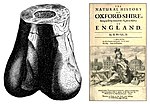Chipping Norton Limestone
| Chipping Norton Limestone Stratigraphic range: Bathonian ~ | |
|---|---|
 Exposure of the Hook Norton Member at Hook Norton Cutting and Banks | |
| Type | Formation |
| Unit of | Great Oolite Group |
| Underlies | Fuller's Earth & Sharp's Hill Formations |
| Overlies | Grantham, Northampton Sand & Whitby Mudstone Formations |
| Thickness | 0–12 m (0–39 ft) |
| Lithology | |
| Primary | Limestone |
| Other | Mudstone |
| Location | |
| Coordinates | 52°00′N 1°36′W / 52.0°N 1.6°WCoordinates: 52°00′N 1°36′W / 52.0°N 1.6°W |
| Approximate paleocoordinates | 41°36′N 8°48′E / 41.6°N 8.8°E |
| Region | England |
| Country | |
| Extent | North Gloucestershire, north Oxfordshire |
| Type section | |
| Named for | Chipping Norton |
 Chipping Norton Limestone (England)  Chipping Norton Limestone (Oxfordshire) | |
The Chipping Norton Limestone is a geological formation in the Cotswolds, England. It preserves fossils dating back to the Bathonian (Middle Jurassic).[1][2] Including those of dinosaurs Cetiosaurus, Megalosaurus and Cruxicheiros as well as the Tritylodontid Stereognathus. It primarily consists of ooidal limestone.
Fossil content[]
The so-called "Scrotum humanum" remains may have come from this formation.[1]
| Dinosaurs | ||||||
|---|---|---|---|---|---|---|
| Genus | Species | Location | Stratigraphic position | Material | Notes | Images |
| Alocodon[3] | Indeterminate[3] | Gloucestershire[4] | Actually indeterminate ornithischian remains.[4] | |||
| Cetiosaurus[5] | C. giganteus[6] | Oxfordshire[6] | Actually indeterminate sauropod remains.[6] | |||
| Indeterminate[5] | Actually indeterminate sauropod remains.[6] | |||||
| Megalosaurus[5] | Indeterminate[5] | Oxfordshire remains later found to be from an indeterminate theropod.[6] |  | |||
| Omosaurus[6] | O. vetustus[6] | Oxfordshire[6] | Actually indeterminate stegosaur remains.[6] | |||
| Phyllodon[7] | Indeterminate[7] | Gloucestershire[4] | Actually indeterminate ornithischian remains.[4] | |||
| Stegosauria[4] | Indeterminate[4] | Gloucestershire[4] | Previously assigned to Stegosaurus sp. and (tentatively) Omosaurus vetustus.[4] |  "Scrotum humanum" | ||
| Streptospondylus[6] | S. cuvieri[6] | Oxfordshire[6] | "Vertebrae [and] limb elements."[8] | Actually indeterminate theropod remains.[6] | ||
Color key
|
Notes Uncertain or tentative taxa are in small text; |
See also[]
- List of dinosaur-bearing rock formations
- List of fossiliferous stratigraphic units in England
References[]
- ^ a b Weishampel, David B; et al. (2004). "Dinosaur distribution (Middle Jurassic, Europe)." In: Weishampel, David B.; Dodson, Peter; and Osmólska, Halszka (eds.): The Dinosauria, 2nd, Berkeley: University of California Press. Pp. 538–541. ISBN 0-520-24209-2.
- ^ British Geological Survey. "Chipping Norton Limestone Formation". BGS Lexicon of Named Rock Units. Retrieved 2 June 2019.
- ^ a b Listed as "cf. Alocodon sp." in "10.3 Gloucestershire, England; 2. Chipping Norton Formation," in Weishampel, et al. (2004). Page 538.
- ^ a b c d e f g h i j "10.3 Gloucestershire, England; 2. Chipping Norton Formation," in Weishampel, et al. (2004). Page 538.
- ^ a b c d "10.3 Gloucestershire, England; 2. Chipping Norton Formation" and "10.11 Oxfordshire, England; 2. Chipping Norton Formation," in Weishampel, et al. (2004). Pages 538,540.
- ^ a b c d e f g h i j k l m n o "10.11 Oxfordshire, England; 2. Chipping Norton Formation," in Weishampel, et al. (2004). Page 540.
- ^ a b Listed as "cf. Phyllodon sp." in "10.3 Gloucestershire, England; 2. Chipping Norton Formation," in Weishampel, et al. (2004). Page 538.
- ^ "Table 4.1," in Weishampel, et al. (2004). Page 78.
Bibliography[]
- Weishampel, David B.; Dodson, Peter; and Osmólska, Halszka (eds.): The Dinosauria, 2nd, Berkeley: University of California Press. 861 pp. ISBN 0-520-24209-2.
Categories:
- Geologic formations of England
- Middle Jurassic Europe
- Jurassic England
- Jurassic System of Europe
- Bathonian Stage
- Limestone formations
- Paleontology in England